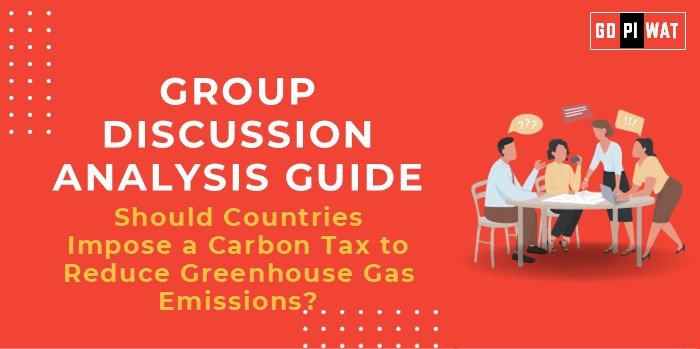📋 Group Discussion (GD) Analysis Guide
🌍 Should Countries Impose a Carbon Tax to Reduce Greenhouse Gas Emissions?
🌐 Introduction to the Topic
Climate change has emerged as one of the most pressing global challenges, requiring urgent and innovative solutions.
One of the key policy tools proposed is the carbon tax, designed to penalize greenhouse gas emissions while incentivizing cleaner energy use.
The concept of a carbon tax originated in the late 20th century as part of market-based environmental reforms.
It has gained traction with countries like Sweden and Canada implementing it successfully.
As climate commitments intensify under the Paris Agreement, carbon taxation stands at the forefront of potential solutions.
📊 Quick Facts and Key Statistics
- 🌍 Global CO2 Emissions: 36.8 billion metric tons in 2023 – highlighting the scale of the challenge.
- 📈 Countries with Carbon Taxes: Over 25 countries, including Sweden ($137/ton CO2) and Canada (increasing to $170/ton CO2 by 2030).
- 🌟 Impact of Sweden’s Carbon Tax: 30% reduction in emissions since 1990, while GDP grew by over 78%.
- 💰 Global Climate Costs: Estimated $2.4 trillion annually by 2030 due to inaction on emissions.
👥 Stakeholders and Their Roles
- Governments: Policy formulation, tax enforcement, and allocation of revenues.
- Corporates: Compliance through cleaner production methods or investing in offsets.
- Citizens: Behavioral changes due to increased costs of carbon-intensive products.
- International Bodies: Monitoring and advising on uniform carbon pricing mechanisms (e.g., World Bank’s Carbon Pricing Leadership Coalition).
🏆 Achievements and ⚠️ Challenges
✅ Achievements:
- Reduced emissions in Sweden and British Columbia through revenue-neutral taxes.
- Encourages innovation in green technology (e.g., solar and wind).
- Creates funds for public green initiatives using tax revenues.
⚠️ Challenges:
- Risk of economic strain on industries in developing countries.
- Political resistance due to public perception of higher costs.
- Global inequality in implementing carbon taxes (developed vs. developing nations).
🌍 Global Comparisons:
- Success: Sweden’s carbon tax coupled with economic growth.
- Struggles: Australia’s repealed carbon tax due to economic pressures and political opposition.
📚 Structured Arguments for Discussion
- Supporting Stance: “Carbon taxes are a proven mechanism to curb emissions while fostering innovation in renewable energy.”
- Opposing Stance: “Imposing carbon taxes disproportionately impacts the poor and small industries, especially in developing nations.”
- Balanced Perspective: “While effective in reducing emissions, carbon taxes must be coupled with subsidies for green alternatives to mitigate economic impacts.”
💡 Effective Discussion Approaches
- Opening Approaches:
- “Global emissions have surpassed 36 billion metric tons annually, and a carbon tax could be a critical step to reversing this trend.”
- “Sweden’s model shows us the dual benefits of emission reductions and economic growth.”
- Counter-Argument Handling:
- Use data (e.g., Sweden’s success) to counter cost-related arguments.
- Highlight complementary policies (e.g., green subsidies) to mitigate impact on vulnerable populations.
🔍 Strategic Analysis of Strengths and Weaknesses
- Strengths: Reduces emissions, incentivizes innovation, generates funds for climate projects.
- Weaknesses: Economic burden on industries, political opposition, potential increase in costs for citizens.
- Opportunities: Transition to green jobs, leadership in climate action, fostering international cooperation.
- Threats: Implementation barriers, public backlash, and unfair competition without global uniformity.
🎓 Connecting with B-School Applications
- Real-World Applications: Links to courses on sustainability in finance, global trade policies, and operational efficiency.
- Sample Interview Questions:
- “How can a carbon tax be implemented without harming economic growth?”
- “Compare carbon taxation to cap-and-trade systems.”
- Insights: Importance of balancing economic and environmental priorities, skills in policy analysis, and innovation strategies.


